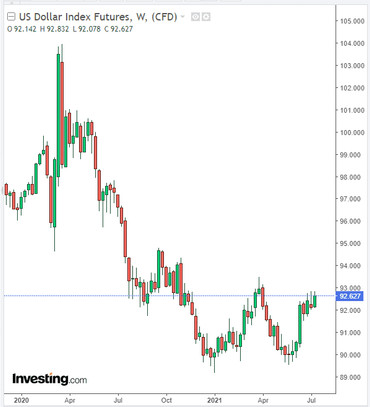Fed Chairman Jerome Powell, speaking Wednesday at the House of Representatives Financial Services Committee, said the central bank will not rush to cut monthly asset purchases and that the economy is "still far" from the Fed's targets. On Thursday, in front of the Senate Banking Committee, he repeated roughly the same words that no reduction in asset purchases is yet envisaged. Nevertheless, Powell acknowledged that inflation is growing faster than expected, and if it goes beyond the acceptable limits, monetary policy will have to be tightened ahead of schedule.
He said that the recent rise in consumer prices has pushed inflation out of the short-term target zone “slightly” above 2%, and this is “a shock to the system ...”. “Of course, we are not satisfied with this", Powell said, noting that Fed officials are closely monitoring inflation expectations to see if they need to reconsider their position.
Worries about how long inflation will last, how it will affect future earnings and the stock market, given the growing likelihood that the Federal Reserve may begin phasing out stimulus policies ahead of schedule, and worries about the spread of the coronavirus worsen investor sentiment and support the US dollar, weakening other currencies, primarily commodities.
Thus, the AUD / USD pair dropped 0.7% on Thursday to the level of 0.7425, remaining in a downtrend since the beginning of May.
The pressure on the AUD / USD is increasing amid the strengthening of the US dollar after the publication of inflation data in the United States (the core CPI published earlier this week showed an increase of +4.5% (in annual terms), although economists were expecting an increase of +4.0%, and on a monthly basis - by +0.9%, higher than the previous value of +0.7% and the forecast of +0.4%) and the rapid spread of the delta coronavirus strain in Australia. Victoria state was locked down for five days on Thursday following a spike in COVID-19 infections. An extension of the Sydney lockdown (accounting for about a quarter of the country's GDP) and weakening economic growth could cool Australia's labor market in the short term, economists say. This will slow progress towards inflation and employment targets set by the central bank, they said. In the opinion of some economists, in the third quarter, the economic recovery in Australia may stop and be replaced by a contraction if the lockdown continues in August.
As a result of the meeting ended at the beginning of the month, the RBA kept the key interest rate and the target level of yield on 3-year government bonds at a record low of 0.10% and announced plans to launch the third round of QE. In the accompanying statement, it was also noted that “the Central Bank will not raise rates until the actual inflation is stable in the range of 2%-3%. According to the baseline scenario, the optimal conditions for the start of the rate hike will not be created earlier than 2024”.
Meanwhile, positive macro data continue to arrive from the US, indicating an accelerating recovery of the economy and the labor market. The number of initial jobless claims for the week of July 4-10 fell by 26,000 to 360,000 in the week of July 4-10, the data released Thursday showed, the lowest since March 2020, when the Covid-19 pandemic hit the economy. Earlier this month, the Labor Department released data that showed US jobs rose by 850,000 in June, after rising 583,000 in May. This data speaks of high labor demand and indicates that many Americans are looking for work again.
The US import price index rose 1% in June, while import prices excluding oil rose 0.7% in June. The New York Fed Manufacturing Index rose to 43.0 in July from 17.4 in June, well above the forecast of economists who had expected the index to be 17.3 in July.
The index of business activity of the Fed-Philadelphia in July was 21.9 against 30.7 a month earlier. The July index indicates continued robust growth in overall manufacturing activity in the region, albeit at a slightly slower pace compared to multi-decade highs in March and April.
Industrial production in the US rose 0.4% in June compared to May, according to data from the Federal Reserve System released on Thursday, which also indicates a good recovery in this critical sector of the US economy.
Today, investors will wait for the publication at the beginning of the American trading session (at 12:30 GMT) of June statistics on retail sales in the United States, which will help to further assess the level of inflationary pressures in the country.
Volatility in dollar quotes and, accordingly, the AUD / USD pair may also increase at 14:00 (GMT) with the publication of the University of Michigan Consumer Confidence Index.
This indicator reflects the confidence of American consumers in the economic development of the country. A high level indicates economic growth. This indicator is expected to be released in July at 86.5. Previous values of the indicator: 85.5 in June, 84.9 in March, 76.8 in February, 79.0 in January 2021. There is a steady trend towards a gradual recovery in the growth of the indicator, which is positive for the USD.
Meanwhile, at the end of this week, the DXY dollar index returned to 3-month levels, rising to 92.63 by the time this article was published (this week's high is at 92.83) and maintaining the potential for further gains.






